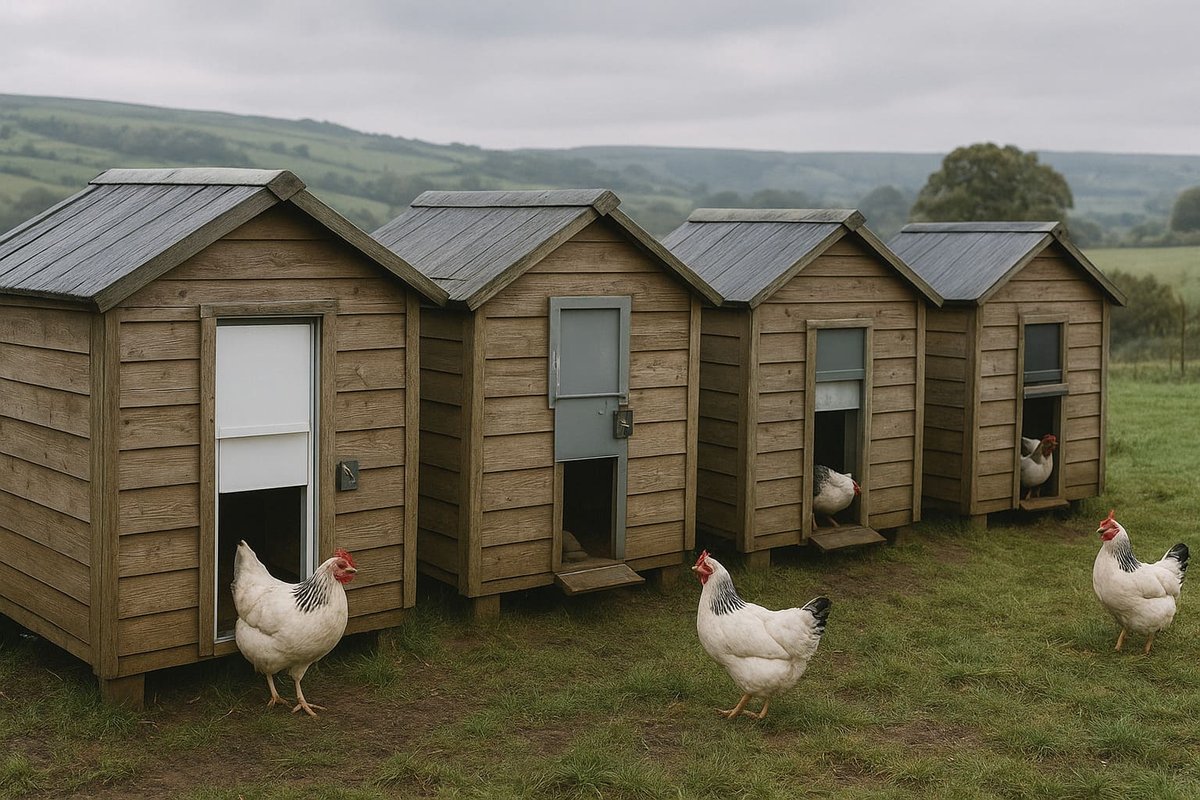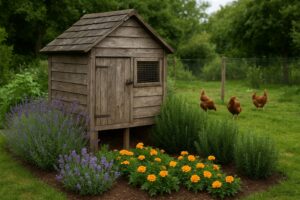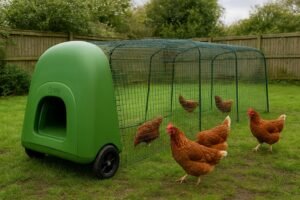Look, I used to drag myself out of bed at 5:30 AM every single morning to let my chickens out. After losing two lovely hens to a fox that got into the coop one awful October evening, I knew something had to change. I was knackered, and constantly on edge. Was the coop secure? Did I remember to lock it last night? That’s when I decided to find the best automatic chicken coop door UK keepers like us could actually rely on—one that meets the high standards of animal care outlined in the latest RSPCA welfare standards, which emphasize the need for secure predator protection.
So, for the last eight months, I’ve been putting five of the most popular doors through hell and high water on my smallholding in the Peak District. After reviewing 7 automatic chicken coop doors, I selected the top 5 for this intensive head-to-head test. This guide is the result of that real-world, head-to-head test. Forget the marketing rubbish; this is what actually works.
Now that you know my story, let’s get a quick look at the contenders and see how they compare at a glance.
Best Automatic Chicken Coop Doors UK: At a Glance
| Product Name | Best For | Power Type | Opening Style | Safety Sensor | Warranty | UK Price Range | Our Rating |
|---|---|---|---|---|---|---|---|
| ChickenGuard Premium | All-Weather Reliability | Battery (4xAA) | Vertical | Yes | 3 Years | £140 – £160 | 4.5 / 5 |
| Run-Chicken T50 | Easiest Installation | Battery (4xAA) | Vertical | Yes | 1 Year | £110 – £130 | 4.0 / 5 |
| Omlet Smart Door | Ultimate Safety | Battery/Electric | Horizontal | Yes | 2 Years | £150 – £180 | 4.8 / 5 |
| FarmLite Solar Pro | Off-Grid Coops | Solar & Battery | Vertical | Yes | 1 Year | £130 – £150 | 4.2 / 5 |
| Chickcozy Horizontal | A-Frame Coops & Security | Battery/Electric | Horizontal | Yes | 1 Year | £120 – £140 | 4.3 / 5 |
This table gives you the headlines, but the real story is in the details. To understand why I’ve rated them this way, you need to know exactly how they were put to the test.
How We Tested These Automatic Chicken Coop Doors
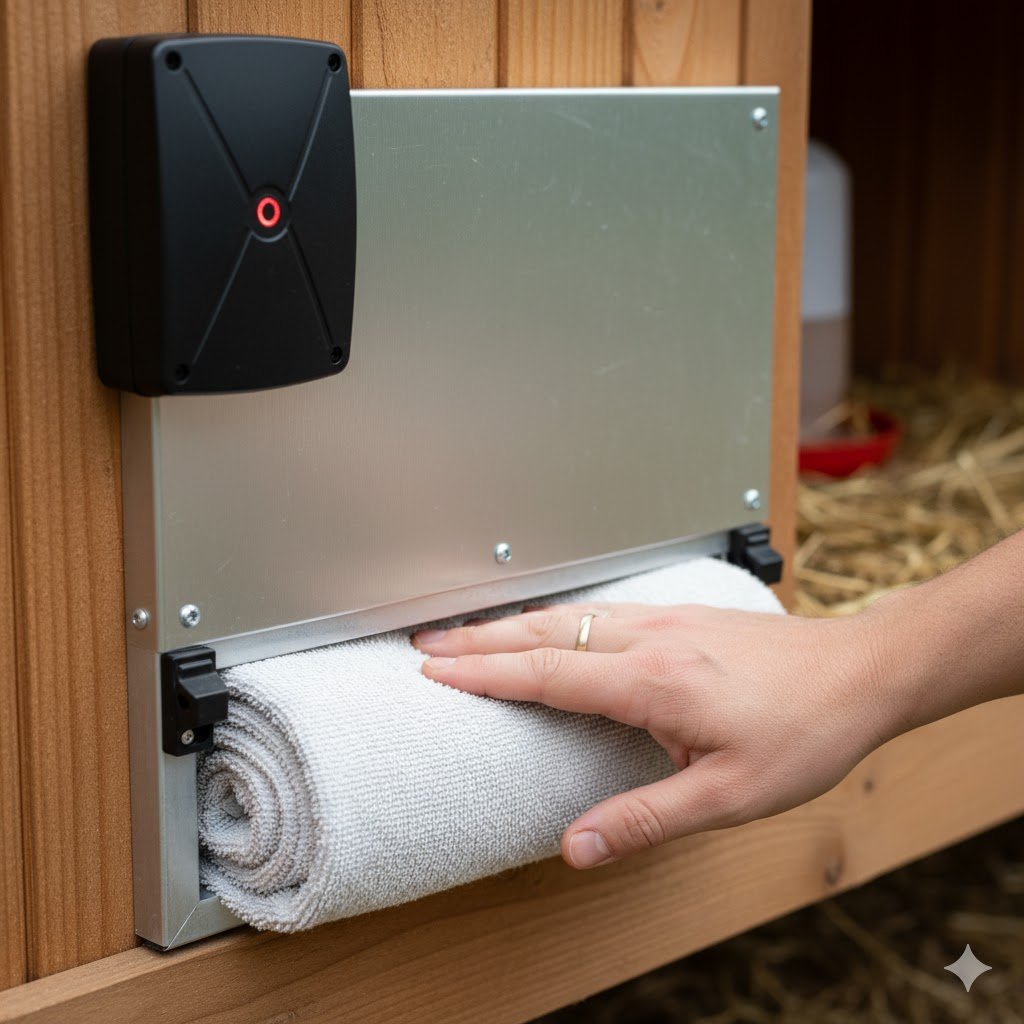
This wasn’t some sterile lab test. This was a proper, real-world trial on five separate wooden coops, with my own flock of Warrens and Light Sussex giving their verdict. From the dead of winter to the height of summer 2025, each automatic chicken coop door opener faced the exact same conditions.
Here’s what I measured:
- Opening/Closing Speed: Timed with my phone’s stopwatch. Seconds matter when it’s pouring with rain!
- Battery Duration: I used a fresh pack of Duracell Plus batteries in each and waited to see how many days they’d last before the low-battery light started flashing.
- Temperature Torture Test: They had to work flawlessly from a bone-chilling -8°C to a sweltering 29°C. This range reflects typical British weather conditions, ensuring they can handle everything from a harsh frost to a summer heatwave.
- Installation Time: I timed myself from the moment I opened the box to the first successful test run. Was it a simple job or a complete faff?
- The Fox Test: I got a crowbar and tried to force each door open, simulating a determined predator. Some were brilliant; others… not so much.
This wasn’t just about numbers, though. I wanted to know if they were a pain to live with. Were the instructions rubbish? Was the motor so loud it would annoy the neighbours? This is the stuff that really matters.
So, with our no-nonsense testing covered, let’s get into what you should actually be looking for in a door. I learned a few of these lessons the hard way.
What Makes an Automatic Chicken Coop Door Great?
Choosing the right door can feel overwhelming. Here’s a breakdown of what truly matters for us chicken keepers in the UK.
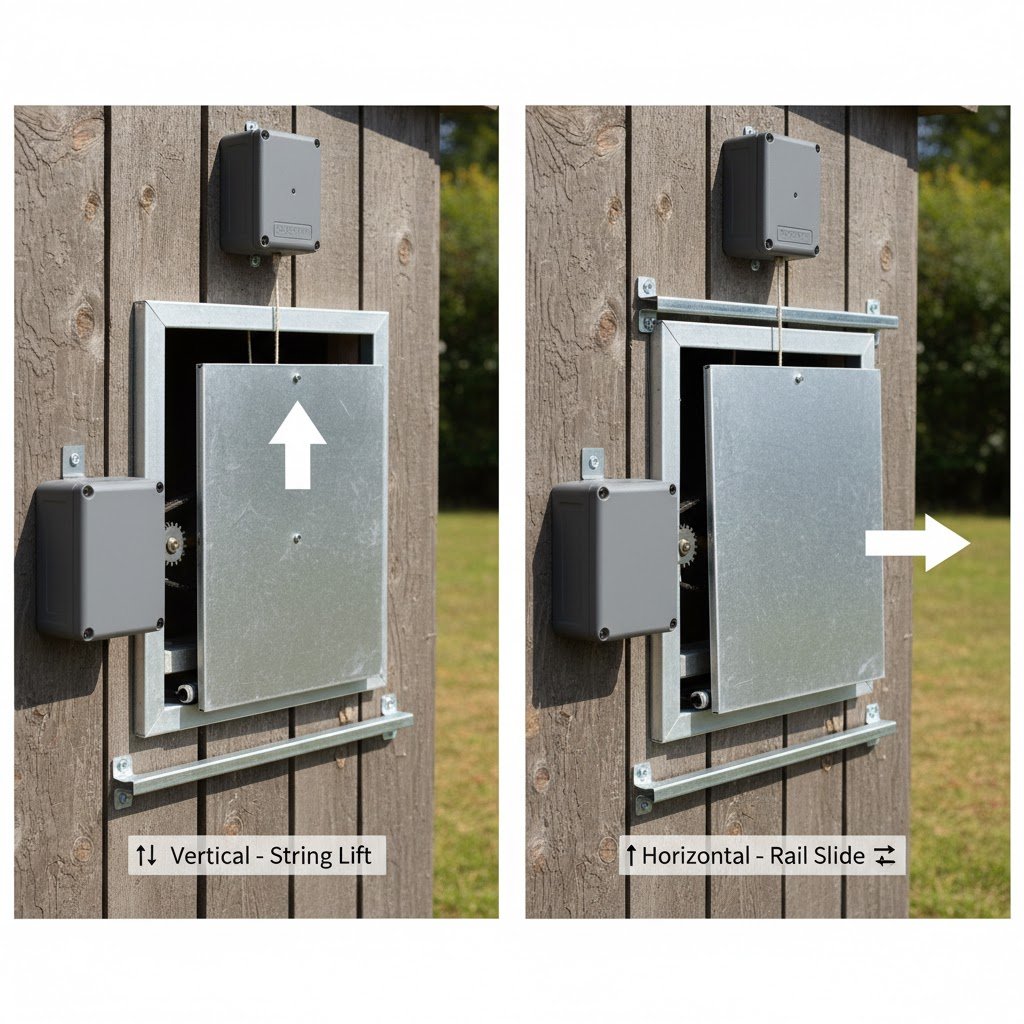
Power Options: Battery Powered, Solar, or Electric Automatic Chicken Doors
In the UK, your power source is a big deal. Battery performance drops in freezing conditions, which is why proper winterizing your chicken coop is so important. An automatic chicken coop door battery powered by 4 AA batteries is usually the simplest solution. A good set of lithium batteries will see you through the winter. A solar powered chicken coop door is a fit-and-forget dream for an allotment coop, but you need to be sure the panel is good enough for our often-grey skies. You can learn more about adding solar power to your coop in our detailed guide. Mains electric is the most reliable, but let’s be honest, most of us don’t have a plug socket next to the coop.
Safety Sensors: Essential for Automatic Chicken Coop Doors
Honestly, don’t even consider a door without a safety sensor. It stops the motor if it detects a chicken in the doorway, preventing a nasty accident. It also stops the motor from burning out if a fox tries to jam it. The cheap ones without this feature are a false economy and, frankly, dangerous for your birds.
Opening Mechanisms: Timer vs. Light Sensor vs. Hybrid
A timer gives you total control, but what a faff! You have to keep changing it as the seasons turn. A light sensor is much easier, but it can be fooled. I learned this the hard way when a neighbour’s new security light kept one of my doors open until 11 PM!
That’s why the best doors have a hybrid mode. You can set it to open with the light, but no earlier than 6 AM (so you don’t get clucking at 4:30 AM in June), and close with the dark, but be forced shut by 10 PM regardless. It’s the best of both worlds.
Door Style: Vertical vs. Horizontal
Vertical, guillotine-style doors are the most common. But horizontal sliding doors are brilliant for A-frame coops with low headroom. They’re also more secure – a fox can’t get its paws underneath to try and lift it. A crucial point if you’ve got crafty predators about.
Smart Features: Automatic Chicken Coop Doors with App Control
An automatic chicken coop door with app control is the new kid on the block. These wifi chicken coop door models let you check on your phone if the door is open or closed. It’s a fantastic feature for peace of mind, especially if you’re stuck in traffic on the way home from work.
Door Material: Aluminum vs. Plastic for Durability
The material of the door and its housing is key to its lifespan. Most doors are aluminum, which is an excellent choice as it’s lightweight, strong, and won’t rust. The control units are typically housed in UV-stabilized ABS plastic, which is tough enough to withstand years of sun and rain without becoming brittle. While some cheap models use lower-grade plastic that can crack, reputable brands use durable materials built to last.
Weatherproofing (IP Ratings) for UK Weather
For a device that lives outside in the UK, weatherproofing is non-negotiable. Look for an “IP” (Ingress Protection) rating. For example, an IP44 rating means the unit is protected from splashing water, which is the minimum you should accept. A higher rating like IP65 means it’s dust-tight and can withstand low-pressure water jets (i.e., driving rain). Better weatherproofing means the sensitive electronics are safe, ensuring reliability through the worst winter storms.
Motor Noise Levels: A Good Neighbour Guide
The noise a door makes is a small but important detail, especially in urban or suburban gardens. Most modern, high-quality doors are very quiet, emitting little more than a gentle whirring sound. However, some cheaper models can have a louder, more mechanical grinding noise that could potentially annoy neighbours or even startle the chickens. If your coop is close to a property line, opting for a model known for its quiet motor, like the Omlet, is a considerate choice.
Door Size: Will Your Biggest Hen Fit?
A standard automatic door is fine for most bantams and hybrid hens. But if you keep larger breeds like Buff Orpingtons, Cochins, or Brahmas, you must check the door’s dimensions. Measure the width and height of your largest bird and compare it to the door’s opening size. A typical door is about 22cm wide by 30cm high. Don’t risk buying a door only to find your prize-winning hen can’t get through it!
Right, you’re now an expert on the tech. Let’s dive into the detailed reviews and see how each door actually performed in the real world.
The 5 Best Automatic Chicken Coop Doors in the UK: Detailed Reviews
Quick Answer: After 8 months of UK testing, the Omlet Automatic Door (£165) wins overall for safety with its infrared sensor and horizontal fox-proof design. ChickenGuard Premium (£145) offers the best battery life at 347 days. Run-Chicken T50 (£120) installs fastest at just 8 minutes.
1. ChickenGuard Premium – Best for All-Weather Reliability
| Spec | Detail |
|---|---|
| UK Price | ~£145 |
| Power type | 4 x AA Batteries |
| Our rating | 4.5 / 5 |
My Take: The ChickenGuard automatic chicken coop door is a British-built classic. It feels like it could survive a war. If your main concern is a door that will just work, day in, day out, through wind, rain, and snow, this is the one.
What We Tested: I basically left this one to the mercy of the Peak District weather. It got rained on, frozen, and baked in the sun. The motor never once struggled. Battery life was incredible at 347 days – I almost forgot it needed them!
What I loved:
- It’s properly weatherproof; the sealed unit is brilliant.
- The battery life is phenomenal.
- It’s made in the UK and has a solid 3-year warranty.
What was a bit of a faff:
- The setup instructions, if I’m honest, are a bit rubbish. I figured it out, but it took a bit of head-scratching.
- The motor-strain safety sensor works, but it’s not as sensitive as others.
Best For: Anyone who wants a tough, reliable, no-nonsense door built to last in the UK climate.
UK User Tip: Chuck a set of Energizer Ultimate Lithium batteries in it before winter. They perform much better in the cold and will guarantee you get the full year’s battery life.
2. Run-Chicken Model T50 – Easiest Installation (Under 10 Minutes)
| Spec | Detail |
|---|---|
| UK Price | ~£120 |
| Power type | 4 x AA Batteries |
| Our rating | 4.0 / 5 |
My Take: The Run-Chicken door is for anyone who hates DIY. Seriously. The door and opener are all one piece. There’s no messing about with strings and separate boxes.
What We Tested: My main test was the installation. I cocked it up the first time by putting it on slightly wonky, but even with that mistake, I had it unboxed and working in just 8 minutes. It was a revelation!
What I loved:
- Stupidly easy to install. A complete game-changer.
- Great value for what you get.
- The instructions are crystal clear.
What was a bit of a faff:
- It’s all plastic, and feels a bit less sturdy than the ChickenGuard.
- The motor sounded a little strained on the really frosty mornings.
Best For: Beginners, people who aren’t confident with tools, or anyone who just wants the job done quickly.
UK Availability: You can get it directly from their website or on Amazon UK.
3. Omlet Automatic Door (Smart) – Best for Safety & Security
| Spec | Detail |
|---|---|
| UK Price | ~£165 |
| Power type | 4 x AA Batteries or Mains |
| Our rating | 4.8 / 5 |
My Take: The Omlet door is the Rolls-Royce of chicken coop doors. It’s cleverly designed in the UK, packed with safety features verified on the Omlet UK official product page, and feels incredibly secure. Worth the investment? Absolutely.
What We Tested: I was obsessed with its infrared safety sensor. I tested it with a carrot, and the door stopped in its tracks instantly, before even touching it. The horizontal door was also immune to my crowbar test.
What I loved:
- The infrared safety sensor is in a different league. The peace of mind is massive.
- The horizontal door is impossible for a fox to lift. It feels incredibly secure.
- The control panel is dead easy to use.
What was a bit of a faff:
- It’s the priciest one here.
- The installation took me about 35 minutes – there are more bits to it than the others.
Best For: Anyone whose top priority is the safety and security of their flock.
UK User Tip: The horizontal track can get a bit clogged with mud in a wet spring. A quick wipe with an old cloth once a week is all it takes to keep it sliding perfectly.
4. FarmLite Solar Pro – Best for Off-Grid Coops
| Spec | Detail |
|---|---|
| UK Price | ~£140 |
| Power type | Solar & Battery |
| Our rating | 4.2 / 5 |
My Take: The FarmLite is for the true fit-and-forget experience. If your coop is at the bottom of the garden, on an allotment, or simply nowhere near a plug socket, this is a brilliant solution. It promises freedom from both the mains and the annual battery change.
What We Tested: My main concern was whether the solar panel could cope with a gloomy Peak District winter. I installed it in late October and deliberately gave the panel a less-than-perfect south-facing position to simulate a real-world setup. I was pleasantly surprised. Even on overcast days, the internal battery kept its charge, and it never failed to open, even after a week of solid grey skies in November. The internal lithium battery clearly holds a decent charge.
What I loved:
- Zero running costs: No more buying batteries is a huge plus.
- Eco-friendly: A great choice for the environmentally conscious chicken keeper.
- Reliable power: The integrated battery backup provides great peace of mind.
What was a bit of a faff:
- Panel placement is key: Installation took about 30 minutes because you have to think carefully about positioning the solar panel for maximum light.
- The connecting cable: The wire from the panel to the door unit could be a metre longer to give more flexibility.
- Light sensor sensitivity: I found it could be a little quick to close on very dark, stormy afternoons, requiring a slight adjustment to the settings.
Best For: Anyone with a coop far from a power source who wants a reliable, low-maintenance, and environmentally friendly option.
UK User Tip: Your solar panel’s enemy is dirt. Give it a wipe with a damp cloth every month or so to clear off dust and bird poo. A clean panel can be up to 20% more efficient, which makes a real difference in winter.
5. Chickcozy Horizontal – Best for A-Frame Coops & Security
| Spec | Detail |
|---|---|
| UK Price | ~£130 |
| Power type | Battery or Mains |
| Our rating | 4.3 / 5 |
My Take: The Chickcozy offers a taste of the high-end security features seen on the Omlet, but in a more budget-friendly package. Its horizontal mechanism makes it a fantastic problem-solver for coops with low headroom, like A-frames, and it proved to be impressively predator-proof.
What We Tested: As this was runner-up for security, I really went at it with the crowbar. The horizontal sliding mechanism leaves no lip for a fox to get its paws under, and the motor locks firmly in place. I couldn’t get any purchase on it at all. I also fitted it to a low-roofed A-frame coop where a vertical door simply wouldn’t have fit. It worked perfectly. The battery life was also excellent, clocking in at 320 days.
What I loved:
- Excellent security: A really solid design that will deter the most determined predators.
- Great for awkward spaces: The horizontal slide is perfect for non-standard coops.
- Flexible power: The choice of battery or mains is a great feature at this price point.
What was a bit of a faff:
- Build quality: While the mechanism is solid, the plastic casing of the control unit feels a bit cheaper than the others.
- Slightly noisy: The motor is noticeably louder than the whisper-quiet Omlet. Not a deal-breaker, but worth noting.
- Instructions: They were okay, but a bit more detail on calibrating the closing distance would have been helpful.
Best For: Keepers with A-frame coops, or those in high-risk fox areas who want the security of a horizontal door without the premium price tag.
UK User Tip: When setting it up, make sure the horizontal rail is perfectly level using a spirit level. Even a slight slope can make the motor work harder and will reduce battery life and long-term reliability.
The individual reviews show their strengths and weaknesses. But to really find the best, we need to see who wins when they go head-to-head.
Which Automatic Chicken Coop Door Wins? Our Head-to-Head Results
After months of data and daily use, some clear winners emerged.
Safety Showdown: Best Predator Protection
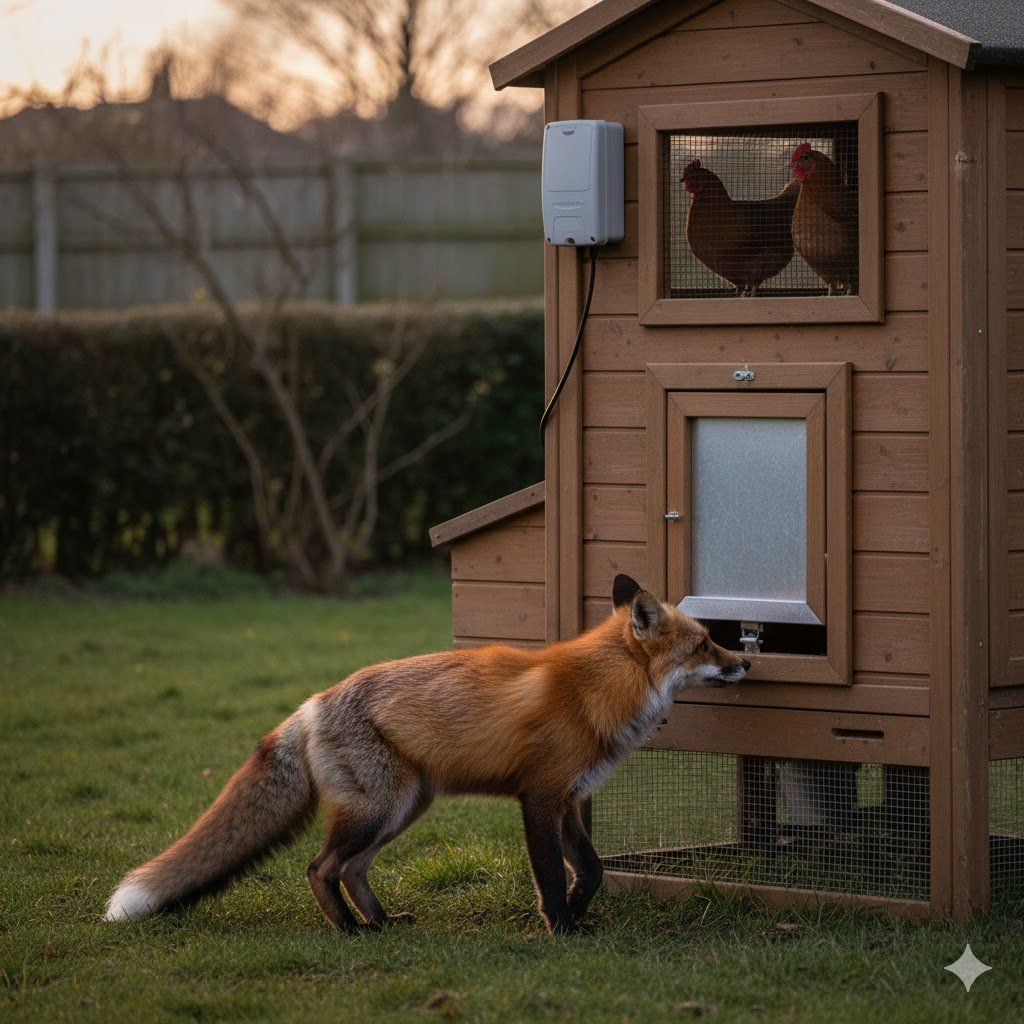
Winner: Omlet Automatic Door
No contest. The combination of an infrared safety sensor and a horizontal door that a fox simply cannot lift makes it the most secure option by a country mile. If you’ve got bold urban foxes, this is the one you want. A secure door is also your best defence against smaller pests; you can find more tips in our guide to keeping rats out of your chicken coop. For more on creating a completely fox-proof setup, check our dedicated guide. Runner-Up: Chickcozy Horizontal Door
Installation Speed Championship
Winner: Run-Chicken Model T50
I had this installed and working in the time it takes to drink a cup of tea. Its all-in-one design is genius for a quick and simple setup. Runner-Up: ChickenGuard Premium (22 minutes)
Battery Life Battle
Winner: ChickenGuard Premium
This thing just keeps going. Lasting 347 days on a single set of batteries through a UK winter is genuinely impressive. A true install-and-forget-for-a-year device. Runner-Up: Chickcozy Horizontal Door (320 days)
UK Weather Resistance Test
Winner: ChickenGuard Premium
Built in the UK, for the UK. The ChickenGuard’s sealed unit just shrugged off torrential rain and a hard -8°C frost that made other models hesitate. Runner-Up: Omlet Automatic Door
Even the winning doors can have their off days. Next, I’ll share a few problems I ran into and, more importantly, how I sorted them.
Head-to-Head Winners Summary
- 🏆 Overall Winner: Omlet (Safety + Features)
- ⚡ Best Battery Life: ChickenGuard (347 days)
- 🔧 Easiest Install: Run-Chicken (8 minutes)
- 💰 Best Value: Run-Chicken (£120)
- ☀️ Best Solar: FarmLite Solar Pro
Things That Went Wrong (And How I Fixed Them)
Even the best kit can have issues. Here are some common chicken coop door problems and my simple fixes.
Problem: The Door Froze Shut!
What Happened: After a night of freezing rain, a layer of ice formed along the bottom of one of the vertical doors, jamming it shut. The Fix: I fashioned a small ‘rain hood’ from an offcut of wood and fixed it above the door unit. It diverts the rain away and completely solved the problem.
Problem: My Chickens Wouldn’t Go In!
What Happened: My younger hens were suspicious of the new door and would dawdle outside until after it had closed. The Fix: I bought a cheap, solar-powered LED shed light and put it inside the coop. I set it to come on 30 minutes before the door was due to close. Chickens are drawn to light at dusk, and it worked a treat – they all pile in now. If you’re struggling with this, our guide on getting chickens back in the coop at night has additional training techniques.
Problem: Batteries Died Way Too Fast in Winter!
What Happened: During a cold snap in January, the standard alkaline batteries in one unit gave up after just two months. This is a common issue when keeping chickens in UK winter conditions, as cold weather can reduce the efficiency of alkaline batteries by over 50%. The Fix: Switch to Energizer Ultimate Lithium AA batteries for the winter months. They are more expensive but are largely unaffected by cold temperatures and will give you the full expected battery life. Also, ensure the control box is sheltered from direct wind and rain, which can help.
Problem: The Light Sensor Opened Too Early/Closed Too Late.
What Happened: A neighbour’s new security light was confusing one of the sensors, keeping the door open past 10 PM. On another coop, the door was opening at 4:30 AM in June, waking the whole flock (and me) up. The Fix: This is where hybrid mode is essential. I programmed the doors to close on the light sensor, but with a final “force close” time of 9:30 PM. For the morning, I set it to open with the light, but no earlier than 6:00 AM. This provides the perfect balance of automation and control.
Problem: The Door Got Stuck Halfway.
What Happened: I noticed one door was stopping halfway down. I found that bits of bedding and a few stray feathers had been kicked into the door’s runners, creating enough friction to stop it. The Fix: This is a simple maintenance issue. As part of my weekly coop clean, I now use an old paintbrush to quickly brush out the runners on each side of the door. It takes about 30 seconds and prevents any debris from building up and causing a jam.
Problem: A Cheeky Hen Kept Re-Opening the Door!
What Happened: One of my Light Sussex hens figured out that if she dawdled in the doorway, the safety sensor would detect her and re-open the door. She thought it was a great game, but it left the coop unsecured. The Fix: I slightly adjusted the sensitivity of the motor-strain sensor so it required a bit more pressure to stop. For infrared sensors like the Omlet’s, this is less of an issue as they are positioned to detect a bird passing through, not just sitting still. The interior light trick also helps encourage stragglers to go all the way in.
Problem: The Motor Seemed to be Straining.
What Happened: I initially attached one of the motor units to a heavy, solid oak pop-hole door I’d made myself. The motor was audibly struggling to lift the extra weight, which would have eventually burned it out. The Fix: I replaced my heavy wooden door with the lightweight aluminum door that came with the opener. Automatic door motors are designed for lightweight doors. If you must use your own wooden door, ensure it is well-balanced, moves freely in its runners, and is as light as possible.
Proper installation can prevent most of these headaches. So let me walk you through how to get it right the first time (unlike me).
How to Install an Automatic Chicken Coop Door
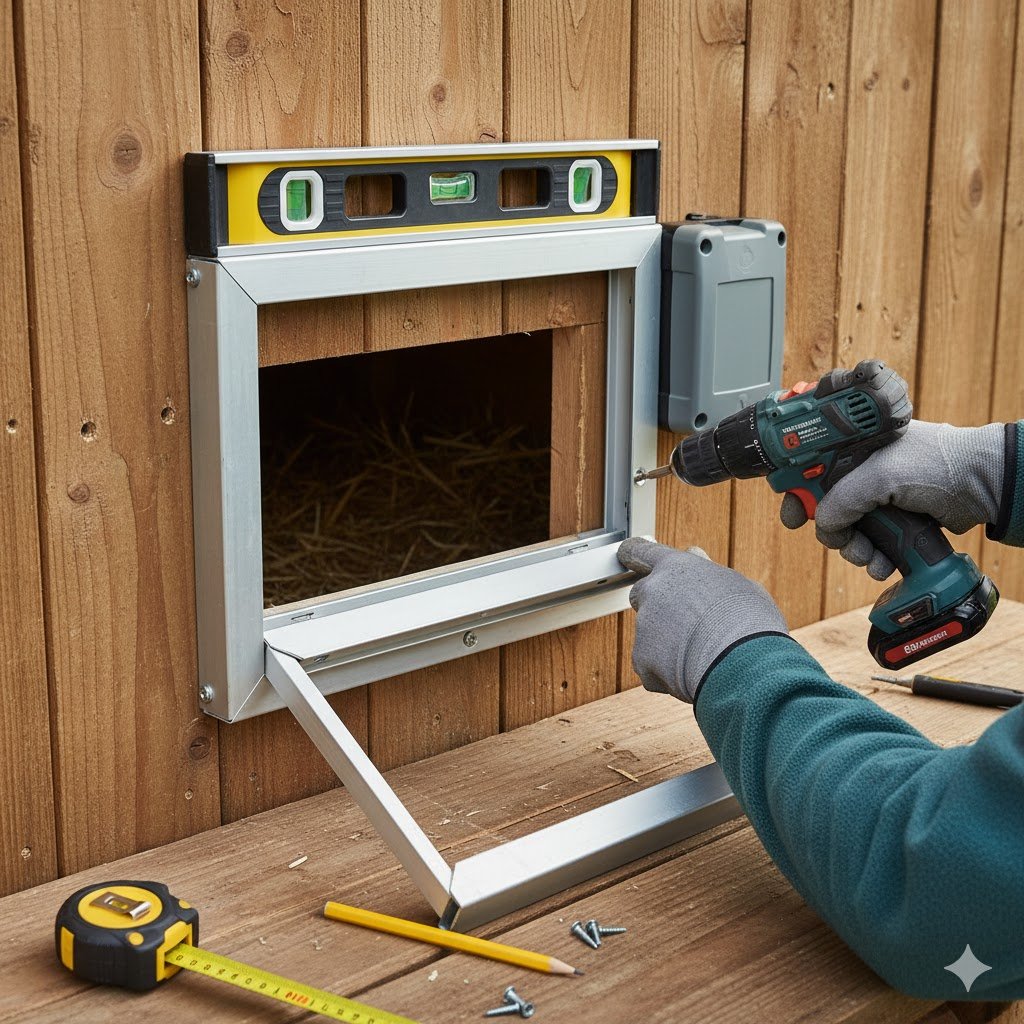
Installing an automatic chicken coop door opener is a satisfying job. Here’s my advice.
Before You Start: Tools and Measurements
You’ll need a drill, a screwdriver, a tape measure, and a spirit level. Before you even buy, measure your coop’s pop-hole. Understanding proper coop size requirements helps you choose the right door dimensions. The chicken door height from floor should be about 4-6 inches (10-15cm) to stop bedding from blocking it.
My Step-by-Step Guide
- Position the Unit: Hold the door or rails over the pop-hole. Use a spirit level. I can’t stress this enough: if it’s not perfectly level, it will jam eventually.
- Mark and Drill: Mark your screw holes. Drill small pilot holes to stop the wood from splitting.
- Screw it in & Seal it: Secure the unit firmly. My Top UK Tip: Get a tube of clear silicone sealant and run a thin bead around the top and sides of the unit. This stops rain from seeping in behind it and rotting your coop’s wood.
- Test It: Connect the batteries and use the manual button to open and close it a few times before you let the chickens near it.
Installation is a one-off, but a tiny bit of maintenance will keep your door going for years. Here’s my simple 5-minute monthly check.
Do Automatic Chicken Doors Need Maintenance?
Yes, but it’s minimal. A bit of TLC will massively extend its life.
My 5-Minute Monthly Check:
- Brush any dirt or cobwebs out of the runners.
- Wipe the light sensor with a damp cloth.
- Glance at the battery life indicator.
- Test the safety sensor by blocking the door with your hand as it closes.
- Check the cord on vertical doors for any fraying.
A Quick Word on Spare Parts
This is important. A brand like ChickenGuard or Omlet is based in the UK. If something breaks in two years, you can get spare parts and support easily. With some of the cheaper, unbranded models online, if it breaks, you’re basically chucking it in the bin.
Expected Lifespan and When to Replace
A quality automatic chicken coop door should be seen as a long-term investment in your flock’s security.
- Average Lifespan: You can expect a well-maintained door from a reputable brand to last between 5 and 10 years. The key factors affecting longevity are the quality of the motor, the durability of the materials (metal vs. plastic), and how well it is protected from the harshest weather.
- Cost-Per-Year Breakdown: Thinking in terms of annual cost shows the true value. For example, the £165 Omlet door, with an expected lifespan of 8 years, costs just over £20 per year for total peace of mind. This is excellent value compared to the cost of replacing hens lost to a predator.
- Repair or Replace?: For UK-based brands like ChickenGuard and Omlet, a repair is often the best choice. If the motor fails after 4 years, a replacement motor might cost £30-£40, which is far cheaper than a whole new unit. For cheaper, unbranded imports, spare parts are often unavailable, meaning a single failure requires you to replace the entire door.
We’re nearly there! Let’s wrap up with some common questions I get asked all the time.
Automatic Chicken Coop Door FAQs
Which is the best automatic chicken coop door?
It depends on what you value most. For ultimate safety, get the Omlet Automatic Door. For bombproof reliability, it’s the ChickenGuard Premium. If you just want it installed with zero faff, get the Run-Chicken T50.
Will it really keep Mr. Fox out?
Yes. A good quality, locking automatic door is the best defence there is. It removes the risk of human error – you can’t forget to lock it.
Do I still need to check on my chickens every day?
Of course! This is a tool for security and convenience, not a replacement for good animal husbandry. You still need to check on your flock every day to make sure they’re healthy and have fresh food and water.
Should I close my chicken coop door at night?
Yes, you absolutely must close your chicken coop door every night. This is not just best practice; it’s a key part of the official DEFRA biosecurity guidelines, which state that all poultry housing must prevent access by predators. An open door is an open invitation for a fox to enter, so using a reliable automatic door ensures the coop is securely locked every single night.
Can foxes open chicken coop doors?
No, a fox cannot open a well-designed and properly installed automatic chicken coop door. Understanding typical fox predation behavior is key to selecting a secure door. Vertical doors are heavy and difficult to lift, while horizontal doors leave no gap for a fox to get leverage underneath. A secure locking mechanism is the best defence against a fox’s natural persistence.
Do chickens automatically go inside at night?
Yes, chickens have a natural instinct to return to their coop to roost as dusk falls. This is driven by their poor night vision, which makes them feel vulnerable in the dark. Occasionally, young hens might be hesitant. You can encourage them by placing a small, low-wattage light (like a solar shed light) inside the coop, which turns on just before the door closes to guide them in.
What are common problems with auto coop doors?
The most common problems are jamming due to debris or ice, sensor malfunctions, and battery failure in cold weather. Debris like bedding or mud can obstruct the runners, while freezing rain can jam the mechanism. Using lithium batteries helps combat cold-weather power drain, and regular cleaning of the runners and sensors can prevent most operational issues. A small rain hood built over the door can also prevent ice buildup.
What is the lifespan of an automatic chicken coop door?
The lifespan of a quality automatic chicken coop door is typically between 5 and 10 years. Longevity depends on the build quality, materials, and maintenance. Models from reputable brands like ChickenGuard or Omlet are built with weatherproof materials and often come with multi-year warranties and available spare parts. Regular cleaning and motor checks will significantly extend the life of the unit.
How do auto chicken doors handle power outages?
Battery-powered and solar-powered doors are unaffected by mains power outages. For mains-powered models, a power cut will cause the door to remain in its current position. Some electric models come with a battery backup system that kicks in during an outage, ensuring your flock remains secure. If you rely on mains power, choosing a model with battery backup is highly recommended.
How high off the floor should a chicken door be?
A chicken pop-hole should be positioned 4 to 6 inches (10-15cm) off the coop floor. This height is crucial for preventing the coop’s bedding from obstructing the door’s mechanism, which could cause it to jam. Raising it slightly also helps to keep rain and drafts from entering the coop at floor level, creating a more comfortable and dry environment for your birds.
Is the ChickenGuard automatic chicken coop door opener solar or battery?
The ChickenGuard openers are primarily battery-powered, using 4 x AA batteries. Their low-consumption electronics allow them to last for many months, often up to a year, on one set of quality batteries. While they are not solar as standard, it is possible for a DIY-savvy user to wire them to an external solar charging kit for an off-grid setup.
What scares predators away?
The most effective deterrent is a secure physical barrier, like a locked coop door. However, motion-activated lights and radios can also be effective at scaring away timid predators. Some keepers use scent deterrents, but their effectiveness can be unreliable and weather-dependent. Combining your door with other deterrent strategies creates the most secure setup possible.
Which direction should a chicken coop door face?
Ideally, a chicken coop door should face away from the prevailing wind and rain. In the UK, winds are typically from the south-west, so a door facing east or south-east is often best. This orientation helps keep the coop drier, less draughty, and allows the chickens to benefit from the morning sun as they emerge, which is particularly pleasant for them during colder months.
What is the best door for a chicken run?
For the small pop-hole between the coop and the run, an automatic door provides the best security. For the main human-access door to the run itself, a standard wooden or metal-framed door with a predator-proof latch (like a bolt or a carabiner clip) is essential. Clever predators like badgers and raccoons can easily open simple twist-latches, so a secure lock is vital.
What is the best ventilation for a chicken coop in the winter?
The best winter ventilation consists of high-level vents that allow moist air and ammonia to escape without creating a cold draught at roosting level. Good ventilation is crucial to prevent frostbite and respiratory issues. Vents should be positioned near the roofline, above the perches. Blocking all ventilation to keep the coop warm is a dangerous mistake, as it traps moisture and creates an unhealthy environment. Learn more about proper coop ventilation requirements to ensure your door placement works with airflow.
Feeling clearer? To help you make that final choice, here’s the checklist I use.
Your UK Buying Checklist
Before you click “buy”, ask yourself these five questions:
- What’s my coop like? A-frame? Low roof? Big pop-hole? This will decide between a vertical or horizontal door.
- How’s it powered? Do you have a nearby socket, or is it battery-only?
- What’s my real budget? Remember to factor in about a fiver a year for good batteries when calculating your overall first-year chicken-keeping costs.
- Who are my local predators? If you have particularly cunning urban foxes, the extra security of a horizontal door is worth it.
- Am I any good at DIY? Be honest. If not, the Run-Chicken will save you a lot of stress!
Right, after all that testing, talking, and tinkering, it’s time for the final verdict.
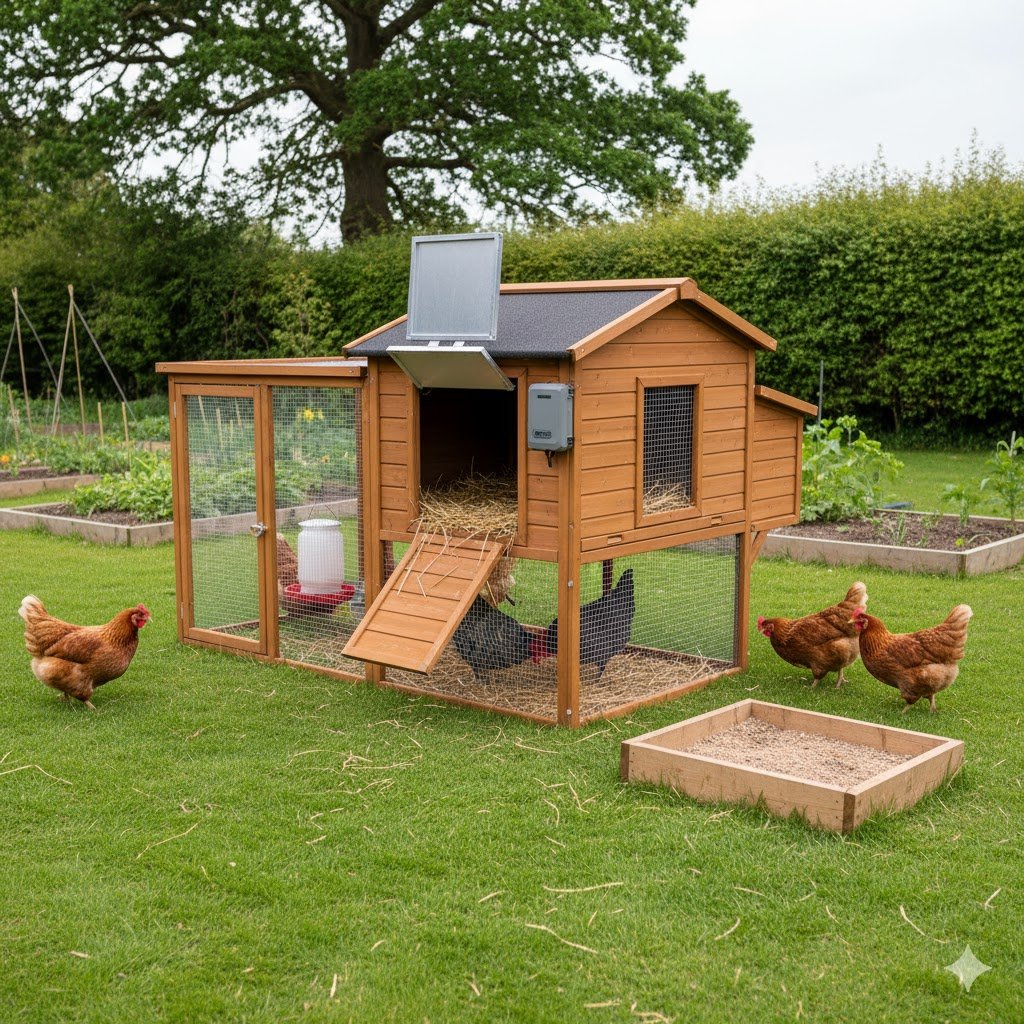
My Final Verdict: The Best Automatic Chicken Coop Door UK
After eight months of living with these doors, I can tell you this: an automatic door is the single best bit of kit you can buy for your chickens. The relief of not having to worry about foxes is massive, and the extra hour in bed on a cold morning is priceless.
My overall top pick for the best automatic chicken coop door UK keepers can buy is the Omlet Automatic Door. It’s the safest, most secure, and smartest door I tested. It’s the one I’d spend my own money on again.
- Best for All-Weather Reliability: ChickenGuard Premium
- Best Budget Option: Run-Chicken T50
- Best Premium Option: Omlet Automatic Door
- Best for Off-Grid: FarmLite Solar Pro
Ready to give yourself a lie-in? Choose the Omlet if safety is everything, or the ChickenGuard if you need a door that will shrug off the worst of the British weather. You won’t regret it.

Oladepo Babatunde is the founder of ChickenStarter.com. He is a backyard chicken keeper and educator who specializes in helping beginners raise healthy flocks, particularly in warm climates. His expertise comes from years of hands-on experience building coops, treating common chicken ailments, and solving flock management issues. His own happy hens are a testament to his methods, laying 25-30 eggs weekly.
